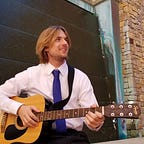Treat Parkinson’s Disease with Music Therapy: Here’s How
Parkinson’s disease (PD) affects your motor skills, such as having difficulty with walking and tremors, and causes other problems like depression, anxiety, and even lack of bladder control1. It will impair health-related quality of life2, but the good news is that music therapy can help Parkinson’s patients improve their symptoms3. Music Therapy may also help improve cognitive functions and quality of life in Parkinson’s patients, but the evidence for these isn’t as clear4.
Singing may actually help people with Parkinson’s, but the evidence for this is far from undeniable5. Although the research isn’t reporting adverse effects, the evidence for singing to improve speech is statistically significant less often than it is not statistically significant, but it still trends in favor of improvement through singing when it is not significant6. The problem is that there is only one study showing adequate support for it6,7.
Even so, Parkinson’s symptoms may be better suited for group therapy and group singing8,9, because, generally speaking and not specific to Parkinson’s disease, group singing can help activate neural pathways associated with attention, emotion processing, memory, language, and speech motor control10,11. Group singing over time can help induce neuroplasticity between the brain regions associated with language and speech activities12,13. It can also connect rhythm and the movement together to engage in complex timed interactions between the auditory and motor systems14. Group singing can even bring people together and connect a person to their memories12,13.
So, there’s potential for singing to help people with Parkinson’s improve their speech skills, but music therapy, specifically movement-based music therapy can significantly improve motor functions4,14, especially for gait14. Gait improves at speeds above the patient’s preferred walking speed16, and the research is consistently showing improvement in velocity, stride length, and symmetry during music therapy17.
Movement-based music therapy includes having the patient play simple rhythms18, following rhythms, and dancing19,20,21,22. However, how movement-based music therapy helps people with Parkinson’s disease improve their motor skills is not clearly understood but may have to do with entraining to the music4.
References
1. Chaudhuri & Schapira (2009). Non-motor symptoms of Parkinson’s disease: dopaminergic pathophysiology and treatment. https://pubmed.ncbi.nlm.nih.gov/19375664/
2. Martinez-Martin & Deuschl (2007). Effect of medical and surgical interventions on health-related quality of life in Parkinson’s disease. https://pubmed.ncbi.nlm.nih.gov/17343275/
3. Pacchetti, Mancini, Aglieri, Fundaro, Martignoni, & Nappi (2000). Active music therapy in Parkinson’s disease: an integrative method for motor and emotional rehabilitation. https://pubmed.ncbi.nlm.nih.gov/10845352/
4. Zhang, Liiu, Ye, Li, & Chen (2017). Can music-based movement therapy improve motor dysfunction in patients with Parkinson’s disease? Systematic review and meta-analysis. https://pubmed.ncbi.nlm.nih.gov/28634878/
5. Barnish, Atkinson, Barran, & Barnish (2016). Potential benefit of singing for people with Parkinson’s disease: A systematic review. https://pubmed.ncbi.nlm.nih.gov/27258698/
6. Ang, Maddocks, & Higginson (2017). The Effectiveness of Singing or Playing a Wind Instrument in Improvement Respiratory Function in Patients with Long-Term Neurological Conditions: A Systematic Review. https://pubmed.ncbi.nlm.nih.gov/28391305/
7. Monroe, Halaki, Kimfor, & Ballard (2020). The effects of choral singing on communication impairments in acquired brain injury: A systematic review. https://pubmed.ncbi.nlm.nih.gov/32096327/
8. Wight & Miller (2015). Lee Silverman Voice Treat- ment for people with Parkinson’s: audit of outcomes in a routine clinic. https://pubmed.ncbi.nlm.nih.gov/25469736/
9. Stegemoller, Radig, Hibbing, Wingate, & Sapienza (2017). Effects of singing on voice, respiratory control and quality of life in persons with Parkinson’s disease. https://pubmed.ncbi.nlm.nih.gov/26987751/
10. Harrison, Loui, & Harrison (2014). Thrills, chills, frissons, and skin orgasms: toward an integrative model of transcendent psychophysiological experiences in music. https://www.ncbi.nlm.nih.gov/pmc/articles/PMC4107937/
11. Janata (2009) The neural architecture of music-evoked autobiographical memories. https://pubmed.ncbi.nlm.nih.gov/19240137/
12. Jungblut, Huber, Pustelniak, & Schnitker (2012). The impact of rhythm complexity on brain activation during simple singing: An event-related fMRI study. https://pubmed.ncbi.nlm.nih.gov/22082766/
13. Sarkamo et al. (2014). Cognitive, emotional, and social benefits of regular musical activities in early Dementia: Ran- domized controlled study. https://pubmed.ncbi.nlm.nih.gov/24009169/
14. Zatorre, Chen, & Penhune (2007). When the brain plays music: auditory–motor interactions in music perception and production. https://pubmed.ncbi.nlm.nih.gov/17585307/
15. de Dreu, van der Wilk, Poppe, Kwakkel, & van Wegen (2012). Rehabilitation, exercise therapy and music in patients with Parkinson’s disease: A meta-analysis of the effects of music-based movement therapy on walking ability, balance and quality of life.
16. Howe et al. (2003). Auditory cues can modify the gait of persons with early-stage Parkinson’s disease: A method for enhancing Parkinsonian walking performance? https://pubmed.ncbi.nlm.nih.gov/22166406/
17. Weller & Baker (2011). The role of music therapy in physical rehabilitation: A systematic literature review. https://www.ncbi.nlm.nih.gov/books/NBK81025/
18. Pohl, Dizdar, & Hallert (2013) The Ronnie Gardiner rhythm and music method — a feasibility study in Parkinson’s disease. https://pubmed.ncbi.nlm.nih.gov/23480646/
19. Hackney ME, Earhart GM (2009) Health-related quality of life and alternative forms of exercise in Parkinson disease. https://pubmed.ncbi.nlm.nih.gov/19329350/
20. Hackney ME, Earhart GM (2009) Effects of dance on movement control in Parkinson’s disease: a comparison of Argentine tango and American ballroom. https://pubmed.ncbi.nlm.nih.gov/19479161/
21. Hackney ME, Kantorovich S, Levin R, Earhart GM (2007a) Effects of tango on functional mobility in Parkinson’s disease: a prelimi- nary study. https://pubmed.ncbi.nlm.nih.gov/18172414/
22. Hackney ME, Kantorovich S, Earhart GM (2007b) A study on the effects of Argentine tango as a form of partnered dance for those with Parkinson disease and the healthy elderly. https://www.americansforthearts.org/sites/default/files/A%20Study%20on%20the%20Effects%20of%20Argentine.pdf
